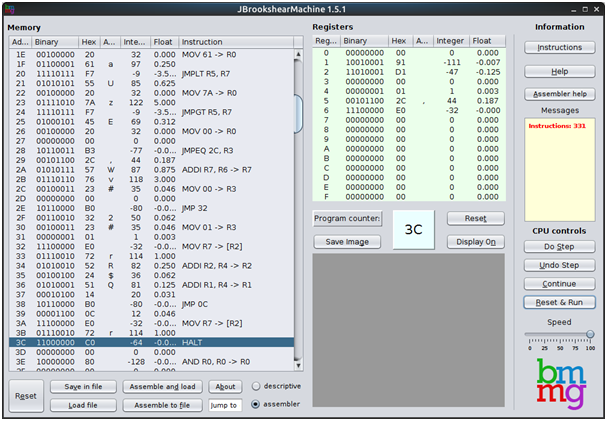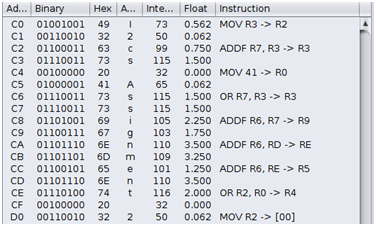Where to Find the Best Assembly Programming Project Help in the UKAssembly programming has been a challenge for many students and so are homework and projects that require knowledge of assembly programming. The highly technical nature of assembly languages makes them the most feared languages in pro...
Data Transfer in Registers
index1 = 0 // initial position in input string index2 = 0 // initial position in output string firstChar = 1 // set firstchar to 1 to change case of nextletter while input[index1] isnotzero do currentChar = input[index1] ifcurrentCharisnotspace ifcurrentCharis a letter iffirstChar == 1 then currentChar = uppercase(currentChar) // convert to uppercase endif endif firstChar = 0 // nextcharis no longer a firstchar else firstChar = 1 // nextcharafter a spaceis a firstchar endif output[index2] = currentChar // savecharacter in output index2 = index2 + 1 // advance to next output position index1 = index1 + 1 // advance to next input position endwhile output[index2] = 0 // saveend of string in outputBM assemblyProgram
MOV [input] -> R1 // load input stringaddress MOV [output] -> R2 // load output stringaddress MOV 1 -> R3 // firstchar = 1 MOV 1 -> R4 // constant 1 forincrements MOV nofirst -> R5 // address of nofirstlabel MOV -32 -> R6 // valueused to convertfromlower to upper loop: MOV [R1] -> R7 // load characterfrom input MOV 0 -> R0 // compare charwithzero JMPEQ endloop, R7 // endtheloopifthecharisend of string MOV +32 -> R0 // compare withspace JMPEQ else, R7 // ifcharacterisspace, go to else MOV "A" -> R0 // forcomparingwith A JMPLT R5, R7 // ifcharis< 'A' it'snotletter MOV "Z" -> R0 // forcomparingwith Z JMPLE R5, R7 // ifcharis<= 'Z' it's a letter, no need to up MOV "a" -> R0 // forcomparingwith a JMPLT R5, R7 // ifcharis< 'a' it'snotletter MOV "z" -> R0 // forcomparingwith z JMPGT R5, R7 // ifcharis> 'z' it'snot a letter MOV 0 -> R0 // load 0 forcomparison JMPEQ nofirst, R3 // iffirstcharis 0, skip ADDI R7, R6 -> R7 // convertfromlower to uppercase nofirst: MOV 0 -> R3 // firstchar = 0 JMP endif // go to nextchar else: MOV 1 -> R3 // it's a space, firstchar = 1 endif: MOV R7 -> [R2] // savecharacter in output ADDI R2, R4 -> R2 // increment position in output string ADDI R1, R4 -> R1 // increment position in input string JMP loop // repeatloop endloop: MOV R7 -> [R2] // saveendingzerocharacter in output HALT // endtheprogram input: DATA 80 // initialaddress of input string output: DATA C0 // initialaddress of output string 80: DATA "i2cs homework2" // test inputDescription
Whentheprogramis run, theregistersstartchanging and theprogramadvancesfrom position 00. Aftera fewsteps, thememorystarting at address C0 isfilledwiththecharactersfromthefirststring, withtheinitialcharactersbeingchanged to uppercase. WhentheprogramreachestheHaltinstruction, the output stringiscorrectlygeneratedstartingat address C0 in memory. Thenumber of instructionsusedbytheprogram to achievetheresultis: 331. The figure belowis a screenshot of theprogramafterbeing run.
Thefollowing figure shows thememorycontentsfromaddress C0, whereit can be seenthatthestring “I2cs Homework 2” isgeneratedcorrectlybytheprogram.
Technicaldescription
Thefollowingregisters are used in theprogram:R0 → used to load valuesforcomparisons.
R1 → current input stringaddress, it has theaddressinput[index1] shown in thealgorithm
R2 → current output stringaddress, it has theaddress output[index2] shown in thealgorithm
R3 → firstcharvalue, it’sthefirstChar variable in thealgorithm
R4 → always has theconstantvalue 1, it’sused to do increments
R5 → address of nofirstlabel, it’sused to makeconditionaljumps
R6 → always has theconstantvalue -32, it’sused to convertlettersfromlower to uppercase
R7 → it’sthecurrentcharacter, corresponds to currentChar in thealgorithm
Themainloopwiththelabel “loop” corresponds to the “while” cycle in thealgorithm, Theelselabel in thecodecorresponds to the “else” part in thealgorithm. The “nofirst” labelcorresponds to the position of “firstChar = 0” inthealgorithm. Thatis, the position afterthefirsttwoendif’s in thealgorithm. The “endif” in thecodecorresponds to thelastendif of thealgorithm, it’sthepartthatisexecutedifthecurrentcharacteris a space. Finally, the “endloop” label in thecodecorresponds to the position afterthe “endwhile” in thealgorithm.
Thememoryisaccessedusingindirectaddressing. In thecode, theregister R1 (R2 forthe output) holdstheaddress of thememory to be accessed, thevalue at this position isloadedusingtheexpression [R1] → register (orwrittenusingregister → [R2]).
Relationshipbetween machine code, assemblylanguage and a high-levellanguage
The machine codeisthelowestrepresentation of anexecutableprogram, itnormallyiswritten in binary and it can be directlyexecutedbythe machine. Theassemblylanguageis a layerabovethe machine code and allowsus to use textormnemonicsinstead of binary to write a program, howevertheinstructionsavailable in assemblyfollowthe machine codeveryclosely and sincetheycan’t be executeddirectlybythe hardware, theymust be translated to machine codeusingan “assembler”. Thehigh-levellanguagesgoanotherabovetheassemblylanguage and allowus to use abstract data types and control structuresbeyondwhatisavailable at the machine level. Theseimprovementsallowus to createcomplexprogramswithouthaving to thinkabouttheconstraintsimposedbythe machine code. Just as in theassemblylanguage case, theprogramswritten in a high-levellanguagecannot be understoodbythe machine so theymust be translated to machine codebeforethey can be executed. In this case, a specialprogramcalled a “compiler” isrequired to translatethehigh-levelcode to machine levelcode.One of theapproachesthatcould be used to develop a compilerfor a computerthatinitiallycouldonly be programmed in machine codeis to writefirstanassembler in machine code, thecompilercouldthen be written in assemblylanguage and be assembled to machine codeusingthe machine codeassembler. Anotherapproachcould be to use a different machine to develop a “crosscompiler”. Thiscrosscompilerwould run in a different machine and thegeneratedexecutableswillcontain machine codeforthe machine wewant to use.

